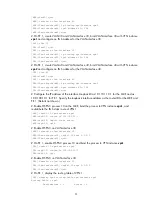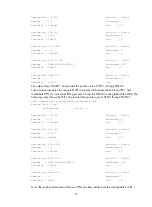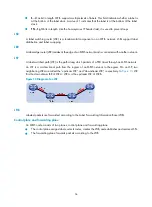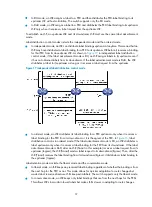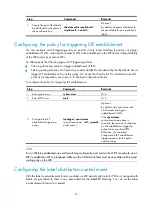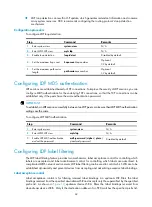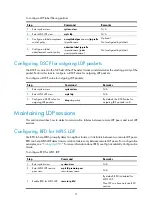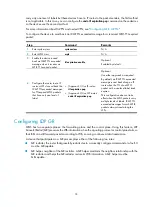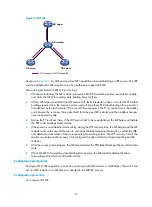
63
Step Command
Remarks
2.
Configure the MPLS LSR ID.
mpls lsr-id
lsr-id
By default, no MPLS LSR ID is
configured.
An MPLS LSR ID is in the format of
an IP address and must be unique
within an MPLS domain. H3C
recommends using the IP address
of a loopback interface on an LSR
as the MPLS LSR ID.
3.
Enable MPLS globally and
enter MPLS view.
mpls
By default, global MPLS is
disabled.
4.
Return to system view.
quit
N/A
5.
Enter interface view.
interface
interface-type
interface-number
N/A
6.
Enable MPLS for the interface.
mpls
By default, MPLS is disabled on
interfaces.
Configuring a static LSP
Before you configure a static LSP, complete the following tasks:
•
Determine the ingress LSR, transit LSRs, and egress LSR for the static LSP.
•
Enable MPLS on all these LSRs.
•
Make sure that the ingress LSR has a route to the FEC destination. This is not required on the transit
LSRs and egress LSR.
When you configure a static LSP, follow these configuration guidelines:
•
The outgoing label of an upstream LSR is the incoming label of its downstream LSR.
•
When you configure a static LSP on the ingress LSR, the next hop specified must be consistent with
the next hop of the optimal route in the routing table. If you configure a static IP route for the LSP, be
sure to specify the same next hop for the static route and the static LSP. For information about
configuring a static IP route, see
Layer 3—IP Routing Configuration Guide
.
•
For an ingress or transit LSR, do not specify the public address of an interface on the LSR as the next
hop address.
To configure a static LSP:
Step Command
Remarks
1.
Enter system view.
system-view



